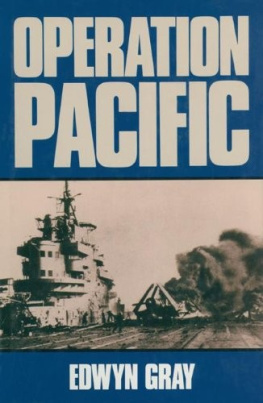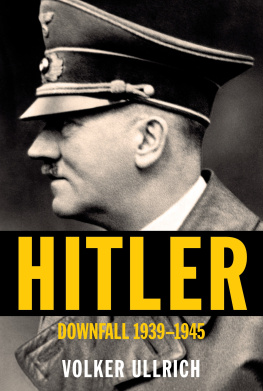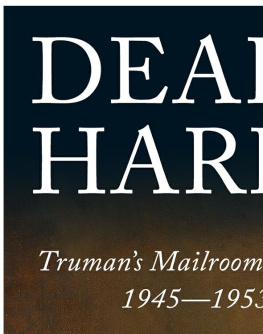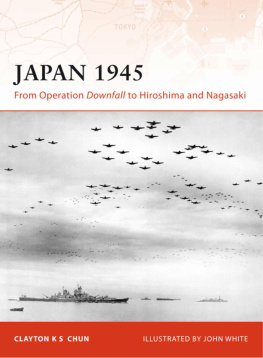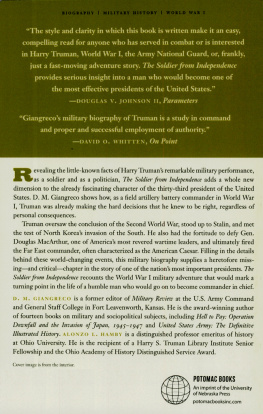This book was made possible through the dedication of the U.S. Naval Academy Class of 1945.
Naval Institute Press
291 Wood Road
Annapolis, MD 21402
2009 by D. M. Giangreco
Chapter 11. To Break Japans Spine and Chapter 17. The Hokkaido Myth 2017 by D. M. Giangreco
All rights reserved. No part of this book may be reproduced or utilized in any form or by any means, electronic or mechanical, including photocopying and recording, or by any information storage and retrieval system, without permission in writing from the publisher.
The Library of Congress has cataloged the first edition as follows:
Giangreco, D. M., date
Hell to pay: Operation Downfall and the invasion of Japan, 19451947 / D.M. Giangreco.
p. cm.
Includes bibliographical references and index.
ISBN 978-1-68247-166-1 (ebook)
1. Operation Downfall, 19451946. 2. World War, 19391945CampaignsJapan. 3. United StatesArmed ForcesHistoryWorld War, 19391945. I. Title.
D767.2.G53 2009
940.54252dc22
2009027766
Maps created by Chris Robinson.

Print editions meet the requirements of ANSI/NISO z39.48-1992 (Permanence of Paper).
252423222120191817987654321
First printing
CONTENTS
IMAGES
M APS
F IGURES
F rom what we learned in the last days and the aftermath of the two-hemisphere world war that closed with the collapse of Nazi Germany and Imperial Japan, we know what the world would have been like had we been unwilling to pay the price to defeat them. Yet as the war dragged on beyond Europe and the casualties escalated, and as some combat veterans began returning while others now never would, the home front was becoming less willing. The public began to lean toward militarily unthinkable negotiations while encouraging Japans submission by air and sea power, thus avoiding the heavy costs of invasion.
In 1945, during the intense final months of World War II, the price of victory was being calculated and its extent determined by three men who, in 1918, had been in uniform in France. One was a Missouri National Guard captain whose 35th Division, in the six days of the culminating Meuse-Argonne offensive, had suffered nearly 7,300 casualties, half its front-line strength. In the interwar years, even before he went to Washington as a senator, Harry Truman rose to Reserve colonel. In wartime he made a sterling reputation heading the U.S. Senate investigating committee on military spending effectiveness. Truman was now president, succeeding Franklin D. Roosevelt, who had died suddenly in mid-April.
Another in the leadership trio who once bore the bird on his shoulders was the now-elderly Secretary of War Henry Stimson, who was once an artillery officer and twice a Cabinet member with War and State Department portfolios under earlier, Republican administrations and who still preferred being called Colonel. The third had been a colonel and on the General Staff of the American Expeditionary Forces during World War I. On his return to the States after the war, he was meanly reduced to his prewar permanent rank of captain. On September 1, 1939, as war again broke out in Europe, George Marshall moved up, as Roosevelts appointee, from the one star he had finally earned, seventeen frustrating years after the army was drastically downsized, to an instant four stars as Army chief of staff.
Some of the major decisions closing the war with Germany and accelerating the downfall of Imperial Japan were inherited by Truman. The feisty accidental president, who took pride in his Oval Office motto, The buck stops here, had to make sweeping decisions advised and backed by Marshall and Stimson. Ironically, the civilian-suited war secretary was more militarily tough-minded than his seemingly austere top general, who now wore his congressionally mandated super rank of five stars, but always, realistically, kept in mind public attitudes, industrial capacity, and logistical limitations. Winston Churchill, who called George Marshall the architect of victory, was not being overly theatrical when he recalled that the British government, its fading imperial sway at stake, was pragmatically resolved to share the agony... [of] the final and perhaps protracted slaughter.
D. M. Giangrecos striking title, Hell to Pay , represents the closing wartime dilemmas and the likely repercussions to their solutions. After ten years of violent aggrandizing in China, Japan had, in 1941, simultaneously and shockingly, attacked four nations over a seventh of the earths surface. Defeating the sprawling Japanese Empire had required fiscal fortitude, technological breakthroughs, immense transfers of men and materiel across two oceans, and continuing evaluation of the terrible human cost of the two-stage invasion of Japan building up on the Pacific RimOperation Downfall. To pacify a fickle electorate believing that a war half-won only required half-mobilization the rest of the way, the American military establishment, at odds with its needs, began sending some seasoned veterans home even as Nazi Germany imploded into chaos.
The complex conditions perceived by both Japanese and American decision makers, and the difficult assessments made at the time, require, in Hell to Pay , the portrayal of vast arrays of numbers. In few books about any subject other than astrophysics are figures more provocativeand more persuasive. Giangreco turns number crunching into high drama. The clouds of supporting aircraft assembled, from the Marianas and the Philippines to Iwo Jima, Okinawa, and dozens of fleet carriers, ran into five figures, so many that they hazarded getting in each others flight paths. The assault shipping (four thousand oceangoing vessels alone) being gathered, and troops committed for the Kyushu landings planned for late October 1945, far exceeded D-Day in Normandy (to face a Japanese buildup that by the time of their surrender totaled nearly 917,000 troops on the island). The coordination of landings in predawn darkness and in the fog of smoke screens risked a nightmare of swampings, collisions, objectives gone awry, and deadly friendly fire. The Japanese intendedconceding extraordinary lossesto inflict 20 percent casualties before any GI set foot on the beaches and further carnage thereafter during the inexorable grind of daily close-in battle conducted at the distance that a man can throw a grenade.



 Print editions meet the requirements of ANSI/NISO z39.48-1992 (Permanence of Paper).
Print editions meet the requirements of ANSI/NISO z39.48-1992 (Permanence of Paper).







